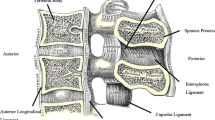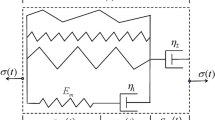Abstract
A new nonlinear constitutive model for the three-dimensional stress relaxation of articular ligaments is proposed. The model accounts for finite strains, anisotropy, and strain-dependent stress relaxation behavior exhibited by these ligaments. The model parameters are identified using published uniaxial stress–stretch and stress relaxation data on human medial collateral ligaments (MCLs) subjected to tensile tests in the fiber and transverse to the fiber directions (Quapp and Weiss in J Biomech Eng Trans ASME 120:757–763, 1998; Bonifasi-Lista et al. in J Orthop Res 23(1):67–76, 2005). The constitutive equation is then used to predict the nonlinear elastic and stress relaxation response of ligaments subjected to shear deformations in the fiber direction and transverse to the fiber direction, and an equibiaxial extension. A direct comparison with stress relaxation data collected by subjecting human MCLs to shear deformation in the fiber direction is presented in order to demonstrate the predictive capabilities of the model.










Similar content being viewed by others
References
Amiel D, Frank C, Harwood F, Fronek J, Akeson W (1983) Tendons and ligaments: a morphological and biochemical comparison. J Orthop Res 1(3):257–265
Bonifasi-Lista C, Lakez SP, Small MS, Weiss JA (2005) Viscoelastic properties of the human medial collateral ligament under longitudinal, transverse and shear loading. J Orthop Res 23(1):67–76
Bustamante R, Merodio J (2010) On simple constitutive restrictions for transversely isotropic nonlinearly elastic materials and isotropic magneto-sensitive elastomers. J Eng Math 68(1):15–26
Davis FM, De Vita R (2012) A nonlinear constitutive model for stress relaxation in ligaments and tendons. Ann Biomed Eng 40(12):2541–2550
Duenwald SE, Vanderby R, Lakes RS (2009) Viscoelastic relaxation and recovery of tendon. Ann Biomed Eng 37(6):1131–1140
Duenwald SE, Vanderby R, Lakes RS (2010) Stress relaxation and recovery in tendon and ligament: experiment and modeling. Biorheology 47(1):1–14
Findley WN, Lai JSY (1967) A modified superposition principle applied to the creep of nonlinear viscoelastic material under abrupt changes in state of combined stress. Trans Soc Rheol 11(3):361–380
Fung YC (1993) Biomechanics, mechanical properties of living tissues, 2nd edn. Springer, New York
Gardiner JC, Weiss JA (2001) Simple shear testing of parallel-fibered planar soft tissues. J Biomech Eng Trans ASME 123(2):170–175
Gardiner JC, Weiss JA (2003) Subject-specific finite element analysis of the human medial collateral ligament during valgus knee loading. J Orthop Res 21(6):1098–1106
Hingorani RV, Provenzano PP, Lakes RS, Escarcega A, Vanderby R (2004) Nonlinear viscoelasticity in rabbit medial collateral ligament. Ann Biomed Eng 32(2):306–312
Holzapfel GA, Ogden RW (2009) On planar biaxial tests for anisotropic nonlinearly elastic solids: a continuum mechanical framework. Math Mech Solids 14(5):474–489
Horgan CO, Murphy JG (2011) Simple shearing of soft biological tissues. Proc R Soc A-Math Phys Eng Sci 467:760–777
Hurschler C, Loitz-Ramage B, Vanderby R (1997) A structurally based stress-stretch relationship for tendon and ligament. J Biomech Eng Trans ASME 119(4):392–399
Johnson GA, Livesay GA, Woo SLY, Rajagopal KR (1996) A single integral finite strain viscoelastic model of ligaments and tendons. J Biomech Eng Trans ASME 118(2):221–226
Kannus P (2000) Structure of the tendon connective tissue. Scand J Med Sci Sports 10(6):312–320
Lanir Y (1983) Constitutive equations for fibrous connective tissues. J Biomech 16(1):1–12
Limbert G, Middleton J (2004) A transversely isotropic viscohyperelastic material—application to the modeling of biological soft connective tissues. Int J Solids Struct 41(15):4237–4260
Merodio J, Ogden RW (2003) A note on strong ellipticity for transversely isotropic linearly elastic solids. Q J Mech Appl Math 56(4):589–591
Merodio J, Ogden RW (2005) Mechanical response of fiber-reinforced incompressible non-linearly elastic solids. Int J Non-Linear Mech 40:213–227
Murphy JG (2012) Tension in the fibres of anisotropic non-linearly hyperelastic materials. some stability results and constitutive restrictions. Int J Solids Struct 50(2):423–428
Pioletti DP, Rakotomanana LR (2000) On the independence of time and strain effects in the stress relaxation of ligaments and tendons. J Biomech 33(12):1729–1732
Pipkin AC, Rogers TG (1968) A non-linear integral representation for viscoelastic behaviour. J Mech Phys Solids 16(1):59–72
Provenzano PP, Lakes RS, Keenan T, Vanderby R (2001) Nonlinear ligament viscoelasticity. Ann Biomed Eng 29(10):908–914
Provenzano PP, Lakes RS, Corr DT, Vanderby R (2002) Application of nonlinear viscoelastic models to describe ligament behavior. Biomech Model Mechanobiol 1(1):45–57
Puso MA, Weiss JA (1998) Finite element implementation of anisotropic quasi-linear viscoelasticity using a discrete spectrum approximation. J Biomech Eng Trans ASME 120(1):62–70
Quapp KM, Weiss JA (1998) Material characterization of human medial collateral ligament. J Biomech Eng Trans ASME 120:757–763
Rajagopal KR, Wineman AS (2009) Response of anisotropic nonlinearly viscoelastic solids. Math Mech Solids 14(5):490–501
Schapery R (1969) On the characterization of nonlinear viscoelastic materials. Polym Eng Sci 9(4):295–310
Thornton GM, Oliynyk A, Frank CB, Shrive NG (1997) Ligament creep cannot be predicted from stress relaxation at low stress: a biomechanical study of the rabbit medial collateral ligament. J Orthop Res 15(5):652–656
Truesdell C, Noll W, Antman SS (2004) The non-linear field theories of mechanics, vol 3. Springer, Berlin
Weiss JA, Gardiner JC, Bonifasi-Lista C (2002) Ligament material behavior is nonlinear, viscoelastic and rate-independent under shear loading. J Biomech 35(7):943–950
Zhang D, Arola DD (2004) Applications of digital image correlation to biological tissues. J Biomed Opt 9(4):691–699
Acknowledgments
Funding was provided by NSF CAREER Grant No. 1150397. Frances M. Davis was supported by the Ford Foundation Pre-Doctoral Fellowship and National Science Foundation Graduate Research Fellowship Program.
Author information
Authors and Affiliations
Corresponding author
Rights and permissions
About this article
Cite this article
Davis, F.M., De Vita, R. A three-dimensional constitutive model for the stress relaxation of articular ligaments. Biomech Model Mechanobiol 13, 653–663 (2014). https://doi.org/10.1007/s10237-013-0525-9
Received:
Accepted:
Published:
Issue Date:
DOI: https://doi.org/10.1007/s10237-013-0525-9




